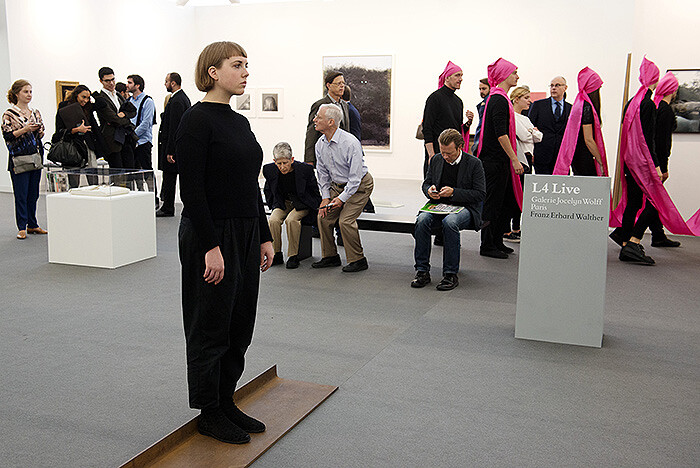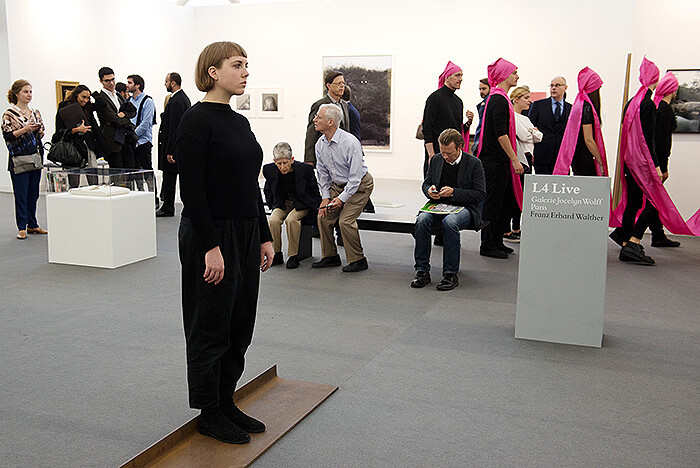October 14–18, 2014
Here’s how you make the most of an art fair booth: hang two-dimensional works on the walls you’ve got, place a large sculpture on the floor in the center, locate a round table with a few chairs in a corner. The result of such standardization is the rise of fair work, which attracts attention by way of scale or repetition. Its most prominent characteristic is its reaction to the architecture of its surroundings through large wall pieces. True to form, the Frieze tent allows artists numerous opportunities to interfere with the temporary structures. Gedi Sibony has hung a ragged brown-gold carpet from the top of Vienna’s Galerie Meyer Kainer’s wall (The Beginning is Near, 2008), allowing it to reach the floor where it is layered over the uniform gray carpeting. Elsewhere, works are attached directly to the light fixtures’ railings, as with Olafur Eliasson’s immense stainless steel ball, Schools of movement sphere (2014) at Tanya Bonakdar, New York, and José Damasceno’s Grua (2010), in which a heavy, rusty hook supports an acrylic disc at Galeria Fortes Vilaça, São Paulo. Others opt for a series of identically framed works meant to make an impression together but sell separately (like the three beautiful untitled Sarah Crowner abstractions, all 2014, hanging side by side and framed in different colors at Galerie Catherine Bastide, Brussels).
Even amongst the transient, prescribed frame of Frieze Art Fair, this year a number of galleries made attempts to break with the format. Hauser & Wirth, London gave over its booth to Mark Wallinger, who curated “A Study in Red and Green.” With walls covered in red and green textiles reminiscent of a nineteenth-century museum, Wallinger installed 72 works, and there’s something for everyone: from Rashid Johnson to Pipilotti Rist, Rita Ackermann to Allan Kaprow. The result is confused and not always logical, but it puts on view exactly the kind of context that a gallery can give an artist—colleagues, collaborators, and other artists to relate to. A fair is a good moment to assess what kind of meaning a roster can give. At Esther Schipper, Berlin, there are works from artists who came to prominence at a similar period, but rarely show alongside each other. Seeing them here allows a new perspective on these artists’ development, and shifts away from the 1990s art theory buzzwords they are commonly associated with. Thomas Demand has created a flowery wallpaper that covers a whole wall (Hanami, 2014), while Pierre Huyghe is showing Timekeeper (Drill Core) from his 2014 show at Museum Ludwig, Cologne: a round piece of the museum’s wall that the artist scraped at, revealing the layers of paints used for previous exhibitions in an extremely tangible reflection on institutional memory. On the walls behind are two of Liam Gillick’s installations with vinyl wall texts (Standard Reference Platform and Restricted Reference Screen, both 2014), and hanging from the light railings (yes) are geometrical mirror sculptures by Tomás Saraceno (SXDF-NB1006-2/M+M, 2014 and NGC 5892, 2013), like miniature versions of his “Cloud City” project for the rooftop of the Metropolitan Museum of Art in 2012.
But the connections that form between artists and artworks are not only generational; they also derive from ideas and form. Gillick’s work, for instance, is also on view at Casey Kaplan, New York, where his shelf-like sculpture interacts beautifully with a canvas by Giorgio Griffa, hanging directly on the wall, unframed, and composed of only spare, colorful horizontal lines. At Galería Elba Benitez, Madrid, Carlos Bunga’s Intento de conservación II (2014)—a niche built into the wall where the artist has displayed cardboard, spot-lit and colored yellow—is a simple gesture that at the gallery’s booth is nuanced in its minimal yet interventionist relation to the fair’s architecture, but which also plays out beautifully in front of Ignasi Aballí’s digital prints of images of the sea, taken from the newspaper El Pais. Also a small gesture, Inventario (Mares) II and Inventario (Mares – Mediterraneo) (both 2014) interpose seascapes collaged from the newspaper, their low-quality gradient making them almost interchangeable, only for the different hues of bitmatrix blue.
All the examples above could also be discussed in terms of “fair work.” None of them are site-specific, and their intention not solely to circulate in art fairs, but they simply function so well at a fair that they have come to be what viewers expect to see. So what is there outside of the predetermined format? One answer is individual works and single-artist exhibitions that allow for more concentrated attention. This is one reason why Frieze’s Focus section, which emphasizes solo presentations, is so successful. London’s Limoncello has brought an impressive large-scale installation from Santo Tolone, a fountain of laminated steel with coins, chains, and other metal objects thrown in it (Fontana Angelica, 2014). It is one of a number of works on view in which objects are submerged in fluids (it’s always amusing to see odd trends pop up at a fair, as with Magali Reus’s sculpture, [Lukes [UV Gamer], 2014] at London’s The Approach, which includes a black plastic bag floating in milky white liquid, and Jason Dodge’s light bulb in a yellow bucket full of water, [Submerged Light, 2014] at Galleria Franco Noero, Turin) but there is a surprising force to the work’s calm and subdued nature, especially considering its size. New York galleries P! and Simone Subal are showing the work of Brian O’Doherty, who brings to the fair a lifetime of experimenting with the boundaries of the visual, here in an installation that changes the viewers’ sense of depth and space as they move around it (Rope Drawing #123: Orange Crush, 2014). Outside Focus, Gió Marconi, Milan, and Meyer Riegger, Berlin, dedicate their shared booth to Rosa Barba, whose installations featuring 35mm projectors have found their way to fairs before, but always placed on the floor in some overlooked corner. The two galleries allow the physical presence of Barba’s pieces—their light, vibration, and sound—to take center stage. Quite literally: the booth structure is a series of platforms on which the projectors are placed and it is seen frontally, as in a theater.
It’s too easy to dismiss art fairs as trade shows. There’s an economy to them, and at times it is painfully plain to see, but predominantly they are a meeting point of production. No fair is as good at this as Frieze is, with its emphasis on new commissions, this year both as part of Frieze Projects and in a new section called Live, in which six galleries present performances across the five days of the fair. It’s an interesting experiment in attention: most performances featured are not of the rock concert type, and thus require quiet concentration from often anxious and rushed fairgoers. A number of the Frieze Projects are also performative. Especially impressive is Nick Mauss’s ballet, which started on opening day with two men in tights and t-shirts that read “All sales final, no refunds,” and will continue to develop with the introduction of new participants—including Kim Gordon—throughout the fair’s duration. And though many of the Frieze commissions this year tend toward the immaterial, Tobias Madison’s installation (Untitled, 2014) forcefully takes over a room made of plywood—basically an inverted fair booth—where inside the darkened space a large black ball hovers over a shallow rectangle filled with black liquid. The result is not welcoming—it is challenging and ominous, bringing in another texture to a fair where not everything is obvious.












